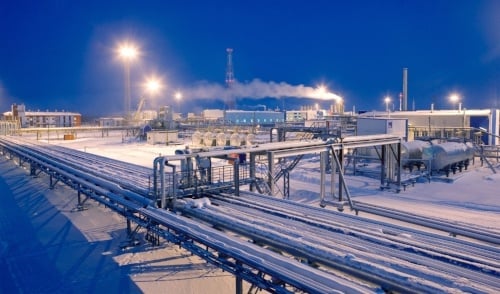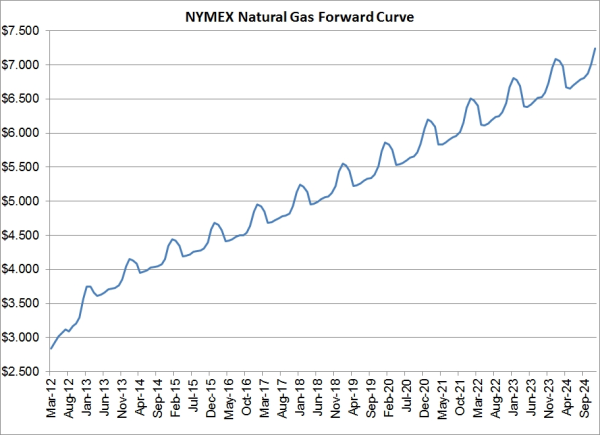3 min read
An Introduction to End-User Natural Gas Hedging - Part I - Futures
This article is the first in a series of several where we are exploring the various hedging strategies which are available to commercial and...

This post is is a continuation of A Primer on Hedging Natural Gas Costs - Part I, which provides a basic introduction to natural gas hedging for commercial and industrial consumers.
As discussed in the previous post, fixed forwards, swaps, options and futures are among the most common strategies used by natural gas consumers to hedge their commodity price risk. This post will explore the basics of each of these strategies.
A fixed forward (also known as a forward contract or fixed price physical contract) is an agreement between two parties to buy or sell physical natural gas at a certain future time, at a specific location(s) at a specific price, which is agreed upon at the time the deal is executed. A natural gas consumer that buys a fixed forward is simply agreeing to purchase a specific quantity of natural gas, from their supplier, for a specific fixed price, to be delivered to a specific location(s), on a specific date or over a specific period of time e,g, one year. Since fixed forwards are traded over the counter (OTC), they can be customized to meet the needs of the natural gas consumers as well as producers, marketers and traders. A fixed forward contract usually contains terms and conditions which may require the buyer and/or seller to pledge collateral, such as a letter of credit, for credit risk management related purposes.
A natural gas futures contract is a firm commitment to make or accept delivery of a specific quantity and quality of natural gas during a specific month in the future at a price agreed upon at the time the commitment is made. Natural gas consumers often buy natural gas futures to "fix" or "lock-in" their futures natural gas costs. Regarding delivery of natural gas futures, only a small percentage of natural gas futures, as well as most commodity futures, result in delivery as most parties will close out their position prior to expiration, solely to avoid making or taking delivery. Natural gas futures are most actively traded on the CME’s Group’s New York Mercantile Exchange (NYMEX) but are also actively traded on other exchanges such as ICE and EEX. Buying and selling natural gas futures require both buyers and sellers to post margin, as well as maintenance margin, with their clearing/brokerage firm, which serves as a credit risk mitigation tool for the clearing firms, exchanges and the customers themselves. Additional details on natural gas futures, including contract specifications, margin requirements, etc. can be found on the respective exchanges’ websites.
A natural gas swap is an OTC contract in which two parties agree to exchange periodic payments as an economic equivalent of physical natural gas. In the most common type of natural gas swap, one party, such as a large natural gas consumer, agrees to pay a fixed price for natural gas on specific dates to a counterparty who, in turn, agrees to pay a floating price for natural gas that references a published price, such as the NYMEX Henry-Hub natural gas futures contract. Natural gas swaps are generally financial transactions that do not involve the purchase or sale of physical natural gas. Natural gas swaps can be traded bilaterally (direct between two counterparties), via an OTC broker or on an electronic trading platform. In addition to fixed price swaps, there are several other types of natural gas swaps such as basis swaps and calendar swaps, which are utilized to hedge basis risk and calendar spread risk, respectively, which we will discuss in future posts. Natural gas swaps are often based on a NAESB or ISDA legal framework which contains, among other things, the terms and conditions of the swap. In recent years, many market participants are utilizing the exchange clearing platforms for credit risk management, which allows both buyers and sellers to transfer their respective credit risks to the respective exchanges rather than being exposed directly to the credit risk of their counterparties.
Natural gas options are contracts that gives the holder the right, but not the obligation, to buy or sell a specified amount of natural gas (or a natural gas swap or futures contract) at a specified price within a specified time in exchange, for an upfront premium, like the premium on an insurance policy. Breaking down the options even further, there are call options and put options.
A natural gas call option is a contract that gives the holder the right, but not the obligation, to buy natural gas at a set price (the strike price) on a given date. A natural gas put option is a contract that gives the holder the right, but not the obligation, to sell natural gas at a set price (the strike price) on a given date. Natural gas options can be options on both futures and swaps. Large natural gas consumers will often purchase natural gas call options to hedge their exposure against rising natural gas prices. Likewise, natural gas consumers can also utilize natural gas put options, often in combination with swaps or futures, to hedge their exposure against declining natural gas prices. As is the case with swaps, many OTC natural gas options can also be cleared via the respective exchanges.
In summary, large natural gas consumers have a variety of options, no pun intended, to hedge their exposure to natural gas price volatility. The "best" hedging tools and strategies for your company will depend on numerous company specific variables such as your goals and objectives, location, risk tolerance, anticipated volumes, financial/credit conditions, etc.
If you are interested in practical, quantitative examples of natural gas hedging strategies, please see the following posts:
An Introduction to End-User Natural Gas Hedging - Part I - Futures
An Introduction to End-User Natural Gas Hedging - Part II - Swaps
An Introduction to End-User Natural Gas Hedging - Part III - Basis
An Introduction to End-User Natural Gas Hedging - Part IV - Call Options
An Introduction to End-User Natural Gas Hedging - Part V - Costless Collars
An Introduction to End-User Natural Gas Hedging - Part VI - Call Spreads

3 min read
This article is the first in a series of several where we are exploring the various hedging strategies which are available to commercial and...

1 min read
As natural gas prices remain depressed, despite the recent bounce, we are receiving numerous inquiries from natural gas producers asking for hedging...

2 min read
This post is the sixth in a series where we are exploring many of the hedging strategies which are available to commercial and industrial natural...